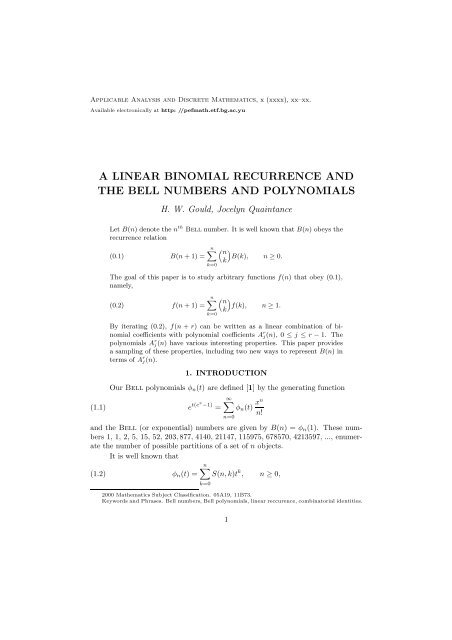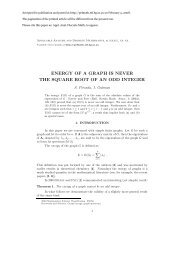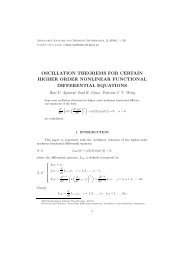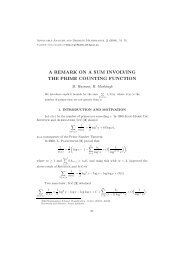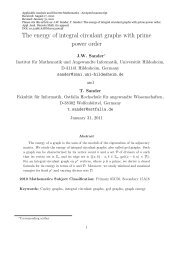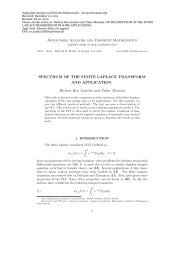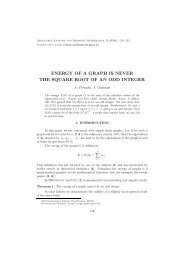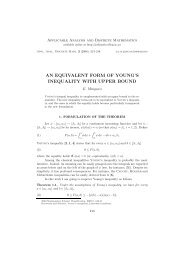a linear binomial recurrence and the bell numbers and polynomials
a linear binomial recurrence and the bell numbers and polynomials
a linear binomial recurrence and the bell numbers and polynomials
You also want an ePaper? Increase the reach of your titles
YUMPU automatically turns print PDFs into web optimized ePapers that Google loves.
Applicable Analysis <strong>and</strong> Discrete Ma<strong>the</strong>matics, x (xxxx), xx–xx.<br />
Available electronically at http: //pefmath.etf.bg.ac.yu<br />
A LINEAR BINOMIAL RECURRENCE AND<br />
THE BELL NUMBERS AND POLYNOMIALS<br />
H. W. Gould, Jocelyn Quaintance<br />
Let B(n) denote <strong>the</strong> n th Bell number. It is well known that B(n) obeys <strong>the</strong><br />
<strong>recurrence</strong> relation<br />
(0.1) B(n + 1) =<br />
n∑<br />
k=0<br />
( n<br />
k)<br />
B(k), n ≥ 0.<br />
The goal of this paper is to study arbitrary functions f(n) that obey (0.1),<br />
namely,<br />
(0.2) f(n + 1) =<br />
n∑<br />
k=0<br />
( n<br />
k)<br />
f(k), n ≥ 1.<br />
By iterating (0.2), f(n + r) can be written as a <strong>linear</strong> combination of <strong>binomial</strong><br />
coefficients with polynomial coefficients A r j(n), 0 ≤ j ≤ r − 1. The<br />
<strong>polynomials</strong> A r j(n) have various interesting properties. This paper provides<br />
a sampling of <strong>the</strong>se properties, including two new ways to represent B(n) in<br />
terms of A r j(n).<br />
1. INTRODUCTION<br />
Our Bell <strong>polynomials</strong> φ n (t) are defined [1] by <strong>the</strong> generating function<br />
∞∑<br />
(1.1) e t(ex−1) = φ n (t) xn<br />
n!<br />
n=0<br />
<strong>and</strong> <strong>the</strong> Bell (or exponential) <strong>numbers</strong> are given by B(n) = φ n (1). These <strong>numbers</strong><br />
1, 1, 2, 5, 15, 52, 203, 877, 4140, 21147, 115975, 678570, 4213597, ..., enumerate<br />
<strong>the</strong> number of possible partitions of a set of n objects.<br />
It is well known that<br />
n∑<br />
(1.2) φ n (t) = S(n, k)t k , n ≥ 0,<br />
k=0<br />
2000 Ma<strong>the</strong>matics Subject Classification. 05A19, 11B73.<br />
Keywords <strong>and</strong> Phrases. Bell <strong>numbers</strong>, Bell <strong>polynomials</strong>, <strong>linear</strong> reccurence, combinatorial identities.<br />
1
2 H. W. Gould, Jocelyn Quaintance<br />
where S(n, k) are <strong>the</strong> Stirling <strong>numbers</strong> of <strong>the</strong> second kind. Moreover,<br />
(1.3) φ n+1 (t) = t<br />
n∑<br />
k=0<br />
( n<br />
k)<br />
φ k (t), n ≥ 0.<br />
In particular, <strong>the</strong> Bell <strong>numbers</strong> satisfy <strong>the</strong> <strong>binomial</strong> <strong>recurrence</strong><br />
n∑ ( n<br />
(1.4) B(n + 1) = B(k), n ≥ 0.<br />
k)<br />
k=0<br />
Our work here is motivated by <strong>the</strong> desire to iterate this expansion <strong>and</strong> determine<br />
<strong>the</strong> coefficients K(n, k, r) so that<br />
(1.5) B(n + r) =<br />
n∑<br />
K(n, k, r)B(k), n ≥ 0, r ≥ 0.<br />
k=0<br />
We will find that a more interesting set of results occurs when we relax <strong>the</strong> condition<br />
n ≥ 0 in (1.3)–(1.4) <strong>and</strong> study <strong>the</strong> general <strong>binomial</strong> <strong>recurrence</strong><br />
(1.6) f(n + 1) =<br />
n∑<br />
k=0<br />
( n<br />
k)<br />
f(k), n ≥ 1,<br />
where f(0) <strong>and</strong> f(1) are arbitrary initial values so that f(n) is uniquely determined<br />
for n ≥ 1 by (1.6).<br />
2. GENERAL EXTENSION OF RECURRENCE (1.6)<br />
From (1.6), we have, by successive substitutions<br />
f(n + 2) =<br />
=<br />
f(n + 3) =<br />
=<br />
n+1<br />
∑ ( ) n + 1<br />
f(k) = f(n + 1) +<br />
k<br />
k=0<br />
n∑<br />
k=0<br />
k=0<br />
( n<br />
k)<br />
f(k) +<br />
n∑<br />
k=0<br />
k=0<br />
( n + 1<br />
)<br />
f(k) =<br />
k<br />
n∑ ( ) n + 1<br />
f(k)<br />
k<br />
n∑<br />
( (n<br />
+<br />
k)<br />
k=0<br />
n+2<br />
∑ ( n + 2<br />
)<br />
f(k) = f(n + 2) + (n + 2)f(n + 1) +<br />
k<br />
k=0<br />
n∑<br />
( ( ( ) ( ) n n + 1 n + 2<br />
(n + 3) + +<br />
k)<br />
) f(k);<br />
k k<br />
( n + 1<br />
) ) f(k);<br />
k<br />
n∑<br />
k=0<br />
( n + 2<br />
)<br />
f(k)<br />
k<br />
f(n + 4) =<br />
n∑<br />
( (n + 3)(n + 6)<br />
( ( ) n n + 1<br />
+ (n + 4)<br />
2 k)<br />
) f(k)<br />
k<br />
k=0<br />
+<br />
n∑<br />
k=0<br />
( (n + 2<br />
)<br />
+<br />
k<br />
( n + 3<br />
) ) f(k);<br />
k
A <strong>linear</strong> <strong>binomial</strong> <strong>recurrence</strong> <strong>and</strong> <strong>the</strong> Bell <strong>numbers</strong> <strong>and</strong> <strong>polynomials</strong> 3<br />
<strong>and</strong> in general, we surmise that f(n+r) may be written using a <strong>linear</strong> combination<br />
( n + j<br />
)<br />
of <strong>the</strong> <strong>binomial</strong> coefficients , j = 0, 1, 2, . . .,r − 1, with coefficients being<br />
k<br />
<strong>polynomials</strong> in n. This we summarize in <strong>the</strong> following <strong>the</strong>orem.<br />
Theorem 2.1. (Extension of <strong>the</strong> general <strong>binomial</strong> <strong>recurrence</strong> (1.6).) There exist<br />
functions A r j (n), which are <strong>polynomials</strong> in n of degree r − 2 − j when 0 ≤ j ≤ r − 2<br />
<strong>and</strong> A r r−1 (n) = 1, such that<br />
(2.1) f(n + r) =<br />
n∑ ∑r−1<br />
( ( n + j<br />
) )<br />
A r j (n) f(k), r ≥ 1, n ≥ 1<br />
k<br />
k=0 j=0<br />
where <strong>the</strong> A ′ s satisfy <strong>the</strong> <strong>recurrence</strong> relation<br />
(2.2) A r+1<br />
j (n) =<br />
r−j−1<br />
∑<br />
i=0<br />
( n + r<br />
)<br />
A r−i<br />
i<br />
j (n), 0 ≤ j ≤ r − 1<br />
<strong>and</strong> with A r+1<br />
r (n) = 1. We assume A r j (n) = 0 for j < 0 or j > r − 1.<br />
Proof. We use induction. By successive substitutions, we have<br />
( ) ( )<br />
n + r<br />
n + r<br />
f(n + r + 1) = f(n + r) + f(n + r − 1) + f(n + r − 2)<br />
1<br />
2<br />
( n + r<br />
)<br />
n∑ ( n + r<br />
)<br />
+ · · · + f(n + 1) + f(k).<br />
r − 1<br />
k<br />
By applying (2.1) to each term, we find<br />
f(n + r + 1) =<br />
n∑<br />
k=0<br />
But we wish to have<br />
( r−1 ∑<br />
j=0<br />
r−j−1<br />
∑<br />
i=0<br />
f(n + r + 1) =<br />
( n + r<br />
)<br />
i<br />
n∑<br />
k=0<br />
( r∑<br />
j=0<br />
A r−i<br />
j<br />
k=0<br />
( n + j<br />
) )<br />
(n) f(k) +<br />
k<br />
( ) n + j<br />
k<br />
A r+1<br />
j<br />
)<br />
(n)<br />
f(k),<br />
n∑<br />
k=0<br />
( n + r<br />
)<br />
f(k).<br />
k<br />
so that by equating <strong>the</strong> coefficients of f(k), we find that (2.2) allows <strong>the</strong> induction<br />
on r to go through.<br />
□<br />
Table 9.1 gives some values of <strong>the</strong> A r j (n). Inspection of this table leads one<br />
to suspect <strong>the</strong> following.<br />
Theorem 2.2. The A r j (n) coefficients satisfy <strong>the</strong> relation<br />
(2.3) A r+1<br />
j+1 (n) = Ar j(n + 1), j ≥ 1, r ≥ 0.
4 H. W. Gould, Jocelyn Quaintance<br />
Proof. We use (2.1) <strong>and</strong> <strong>the</strong> simple fact that (n + 1) + r = n + (r + 1). On <strong>the</strong><br />
one h<strong>and</strong>, we have<br />
n+1<br />
∑<br />
( ∑r−1<br />
( )<br />
n + 1 + j<br />
f(n + 1 + r) =<br />
)A<br />
k<br />
r j (n + 1) f(k)<br />
j=0<br />
On <strong>the</strong> o<strong>the</strong>r h<strong>and</strong>, we have<br />
=<br />
f(n + 1 + r) =<br />
k=0<br />
n+1<br />
∑<br />
k=0<br />
( r∑<br />
j=0<br />
n∑<br />
k=0<br />
( r∑<br />
j=0<br />
( )<br />
n + j<br />
)A<br />
k<br />
r j−1 (n + 1) f(k).<br />
( n + j<br />
) )<br />
A r+1<br />
k<br />
j (n + 1) f(k),<br />
so that by equating <strong>the</strong> coefficients of f(k), we have A r j−1 (n+1) = Ar+1 j (n), which<br />
we restate at (2.3).<br />
□<br />
From this relation, we see that if we compute A r 0 (n) using (2.2), we may <strong>the</strong>n<br />
compute diagonally down <strong>the</strong> table to find all <strong>the</strong> o<strong>the</strong>r A ′ s. This is how we found<br />
A 7 1 (n), since it is equal to A6 0 (n + 1).<br />
We end this section by stating an explicit formula for f(n + 1) in terms of<br />
<strong>the</strong> two initial values of f(0) <strong>and</strong> f(1). This result, which we state as Corollary<br />
2.1, is <strong>the</strong> basis for <strong>the</strong> results given in Sections 8 <strong>and</strong> 9. To prove Corollary 2.1,<br />
we simply let n = 1 in (2.1) <strong>and</strong> rename r as n.<br />
Corollary 2.1. Let f(n) be defined by recursion (1.6). Then<br />
n−1<br />
∑<br />
n−1<br />
(2.4) f(n + 1) = f(0) A n j (1) + f(1) ∑<br />
(j + 1)A n j (1), r ≥ 1<br />
j=0<br />
j=0<br />
Remark 2.1. In view of (2.3), we can rewrite (2.4) as<br />
n−1<br />
∑<br />
f(n + 1) = f(0)<br />
j=0<br />
n−1<br />
∑<br />
j+1 (0) + f(1) (j + 1)A n+1<br />
j+1 (0), r ≥ 1<br />
A n+1<br />
j=0<br />
3. GENERALIZING THE NUMBER OF INITIAL CONDITIONS<br />
We have assumed that (1.6) held for all n ≥ 1. For <strong>the</strong> Bell <strong>numbers</strong>, it<br />
holds for all n ≥ 0. It is natural to ask what we can say when we only assume that<br />
(1.6) holds for all n ≥ a, where a is a non-negative integer, <strong>and</strong> f(0), f(1), . . .,f(a)<br />
are prescribed values. It is easy to see that we have <strong>the</strong> following result, which is<br />
a generalization of Theorem 2.1 <strong>and</strong> Corollary 2.2.<br />
Theorem 3.1. Let f(0), f(1), . . .,f(a) be prescribed values <strong>and</strong> let<br />
n∑ ( n<br />
(3.1) f(n + 1) = f(k), n ≥ a,<br />
k)<br />
k=0
A <strong>linear</strong> <strong>binomial</strong> <strong>recurrence</strong> <strong>and</strong> <strong>the</strong> Bell <strong>numbers</strong> <strong>and</strong> <strong>polynomials</strong> 5<br />
where a ≥ 0 is any given integer. Then,<br />
(3.2) f(n + r) =<br />
n∑<br />
k=0<br />
( r−1<br />
∑<br />
j=0<br />
A r j (n) ( n + j<br />
k<br />
) ) f(k), r ≥ 1, n ≥ a<br />
where <strong>the</strong> A coefficients are <strong>the</strong> same as in Theorem 2.1. Moreover, by letting n = a<br />
in (3.2) <strong>and</strong> <strong>the</strong>n renaming r as n, we note<br />
(3.3) f(n + a) =<br />
a∑<br />
k=0<br />
( n−1<br />
∑<br />
j=0<br />
A n j (a) ( a + j<br />
k<br />
) ) f(k), n ≥ 1.<br />
Example. With a = 2, Equation (3.3) implies that f(n + 2) = C(n)f(0) + D(n)f(1) +<br />
E(n)f(2), where for n ≥ 1,<br />
n−1<br />
∑<br />
n−1<br />
∑<br />
C(n) = A n j (2), D(n) = (2 + j)A n j (2), E(n) =<br />
j=0<br />
j=0<br />
4. BELL NUMBERS<br />
n−1<br />
∑<br />
j=0<br />
(2 + j)(1 + j)<br />
A n j (2).<br />
2<br />
If we take f(n) = B(n), <strong>the</strong>n, as we noted in <strong>the</strong> introduction, relation (1.6)<br />
is valid for all n ≥ 0. Thus, (2.1) becomes<br />
(4.1) B(n + r) =<br />
n∑<br />
( ∑r−1<br />
( n + j<br />
) )<br />
A r j(n) B(k), r ≥ 1, n ≥ 0.<br />
k<br />
j=0<br />
k=0<br />
Setting n = 0 in (4.1), we get <strong>the</strong> explicit formula,<br />
∑r−1<br />
(4.2) B(r) = A r j (0), r ≥ 1.<br />
j=0<br />
This affords a new representation of <strong>the</strong> Bell <strong>numbers</strong> using <strong>the</strong> array of A coefficients.<br />
Thus, we can use <strong>the</strong> row sums Table 9.2 to obtain <strong>the</strong> Bell Numbers,<br />
since <strong>the</strong> n th row sum is <strong>the</strong> n th Bell number. We have been unable to find this<br />
result in <strong>the</strong> literature <strong>and</strong> should note that rows <strong>and</strong> diagonals of <strong>the</strong> array of<br />
A r j (0) <strong>numbers</strong> are conspicuously absent from <strong>the</strong> Online Encyclopedia of Integer<br />
Sequences (OEIS). We have entered <strong>the</strong> sequence A r 0(0), denoted A(r), as A040027<br />
in OEIS, where one can now find references to o<strong>the</strong>r manifestations of this sequence.<br />
A useful simplification of (2.4) by way of (4.2) is as follows:<br />
Corollary 4.1. Let f(n) satisfy (1.6). Then for all r ≥ 1,<br />
(4.3) f(r) = f(0)(B(r) − A(r)) + f(1)A(r).<br />
In fact, Equation (2.4) holds for all r ≥ 0 if we define A(0) = 0.
6 H. W. Gould, Jocelyn Quaintance<br />
Proof. We have from (2.4)<br />
∑r−1<br />
r−1<br />
f(r + 1) = f(0) A r j (1) + f(1) ∑<br />
(j + 1)A r j (1)<br />
j=0<br />
∑r−1<br />
= f(0)<br />
= f(0)<br />
j=0<br />
r∑<br />
j=1<br />
A r+1<br />
j=0<br />
r−1<br />
j+1 (0) + f(1) ∑<br />
(j + 1)A r+1<br />
j+1 (0), by (2.3)<br />
A r+1<br />
j<br />
(0) + f(1)<br />
j=0<br />
r∑<br />
(j)A r+1<br />
j (0)<br />
j=0<br />
= f(0)(B(r + 1) − A(r + 1)) + f(1)<br />
r∑<br />
(j)A r+1 (0), by (4.2) (∗)<br />
Since for <strong>the</strong> Bell <strong>numbers</strong> f(0) = f(1) = 1 <strong>and</strong> f(r + 1) = B(r + 1), we must<br />
have<br />
(4.4)<br />
r∑<br />
j=1<br />
j=0<br />
jA r+1<br />
j (0) = A(r + 1).<br />
Substituting (4.4) into (∗) proves <strong>the</strong> desired result.<br />
Remark. Ano<strong>the</strong>r interesting formula, whose proof is an adaptation of <strong>the</strong> methodology<br />
used for Corollary (4.1), is<br />
∑r−1<br />
j 2 A r j(0) = A(r) + 2A r 1(0).<br />
j=1<br />
In a later paper we will discuss <strong>the</strong> series r−1 ∑<br />
j=1<br />
j p A r j(0).<br />
We are next able to offer ano<strong>the</strong>r remarkable formula for <strong>the</strong> Bell <strong>numbers</strong>.<br />
This formula is given in Corollary 4.2.<br />
Corollary 4.2. Let B(n) be <strong>the</strong> n th Bell number. Then<br />
(4.5) B(n) = A n+1<br />
0 (−1), n ≥ 0.<br />
Proof. In (2.2), set j = 0, n = −1, <strong>and</strong> <strong>the</strong>n replace r by r + 1. We get<br />
so that we have<br />
A r+2<br />
0 (−1) =<br />
r∑<br />
i=0<br />
(4.6) A r+2<br />
0 (−1) =<br />
( r<br />
i)<br />
A r+1−i<br />
0 (−1) =<br />
r∑<br />
i=0<br />
r∑<br />
i=0<br />
j<br />
( r<br />
)<br />
A i+1<br />
r − i<br />
0 (−1),<br />
( r<br />
i)<br />
A i+1<br />
0 (−1), with A 1 0(−1) = 1.<br />
□
A <strong>linear</strong> <strong>binomial</strong> <strong>recurrence</strong> <strong>and</strong> <strong>the</strong> Bell <strong>numbers</strong> <strong>and</strong> <strong>polynomials</strong> 7<br />
We know from (1.4) that <strong>the</strong> Bell <strong>numbers</strong> B(n) satisfy<br />
B(r + 1) =<br />
r∑<br />
i=0<br />
( r<br />
i)<br />
B(i), n ≥ 0,<br />
being <strong>the</strong> unique solution of this with B(0) = 1, whence A i+1<br />
0 (−1) must be identical<br />
to B(i).<br />
□<br />
Remark 4.2. By applying (2.3) to (4.5) we obtain<br />
B(n − j) = A n j−1(−1), n ≥ j ≥ 1.<br />
We propose calling <strong>the</strong> A r j (n) Binomial Recurrence Coefficients. Undoubtedly,<br />
<strong>the</strong>y possess o<strong>the</strong>r remarkable properties, intimately associated with <strong>the</strong> Bell<br />
Numbers. The remaining sections of this paper expound on <strong>the</strong> various properties<br />
of <strong>the</strong> Binomial Recurrence Coefficients.<br />
5. BELL POLYNOMIALS<br />
We wish to next indicate how we can extend <strong>the</strong> concept of <strong>the</strong> Binomial<br />
Recurrence Coefficients to expansions of <strong>the</strong> Bell <strong>polynomials</strong>. If we suppose that<br />
(5.1) φ n+1 (t) = t<br />
<strong>and</strong> iterate <strong>the</strong> relation, we find<br />
n∑<br />
k=0<br />
( n<br />
k)<br />
φ k (t), n ≥ 0,<br />
Theorem 5.1. There exist coefficients A r j (n, t) such that<br />
(5.2) φ n+r (t) =<br />
n∑<br />
( ∑r−1<br />
( ) )<br />
A r n + j<br />
j(n, t) φ<br />
k k (t), n ≥ 0, r ≥ 1,<br />
j=0<br />
k=0<br />
with a <strong>recurrence</strong> relation parallel to (2.2), which is<br />
(5.3) A r+1<br />
j (n, t) = t<br />
r−j−1<br />
∑<br />
i=0<br />
( ) n + r<br />
A r−i<br />
i<br />
j (n, t), 0 ≤ j ≤ r − 1<br />
<strong>and</strong> with A r+1<br />
r (n, t) = 1. Also we assume A r j (n, t) = 0 for j < 0 or j > r − 1.<br />
The formula corresponding to (2.3) is<br />
(5.4) A r+1<br />
j+1 (n, t) = Ar j(n + 1, t), j ≥ 0, r ≥ 0.<br />
Equation (4.2) extends to<br />
∑r−1<br />
(5.5) φ r (t) = A r j (0, t), r ≥ 1.<br />
j=0
8 H. W. Gould, Jocelyn Quaintance<br />
Here are examples of (5.2) for r = 2, 3, <strong>and</strong> 4:<br />
φ n+2 (t) =<br />
φ n+3 (t) =<br />
φ n+4 (t) =<br />
+<br />
n∑<br />
(<br />
φ k (t) t 2( ) ( )<br />
n<br />
) n + 1<br />
+ t ,<br />
k k<br />
n∑<br />
( (t<br />
φ k (t)<br />
3 + (n + 2)t 2)( n<br />
)<br />
+ t<br />
k<br />
2( n + 1<br />
) ( n + 2<br />
) )<br />
+ t ,<br />
k k<br />
k=0<br />
k=0<br />
n∑<br />
k=0<br />
( (<br />
φ k (t) t 4 + (2n + 5)t 3 +<br />
n∑<br />
( (t<br />
φ k (t)<br />
3 + (n + 3)t 2)( n + 1<br />
)<br />
k<br />
k=0<br />
(n + 2)(n + 3)<br />
2<br />
t 2)( )<br />
n<br />
)<br />
k<br />
+ t 2( n + 2<br />
)<br />
+ t<br />
k<br />
( n + 3<br />
) ) .<br />
k<br />
Evidently one may prove also that A r j (n, t) is a polynomial of degree r in t. We<br />
shall name <strong>the</strong>m Binomial Recurrence Polynomials.<br />
6. INVERSE SERIES RELATIONS<br />
We can learn more about <strong>the</strong> array of coefficients A r j (n) by looking at inverse<br />
series relations. We announce <strong>the</strong> following result whose proof we omit:<br />
Theorem 6.1.<br />
∑r−1<br />
(6.1) f(r) = A r j (0)g(j), r ≥ 1<br />
<strong>and</strong> only if<br />
j=0<br />
(6.1) g(r) = f(r + 1) −<br />
r∑<br />
j=1<br />
( r<br />
j)<br />
f(j),<br />
with g(0) = f(1).<br />
From this point of view, <strong>the</strong> array A r j (0) arises as <strong>the</strong> inverse of <strong>the</strong> simple<br />
<strong>binomial</strong> matrix<br />
⎡<br />
M =<br />
⎢<br />
⎣<br />
1 0 0 0 0 0 ...<br />
−1 1 0 0 0 0 ...<br />
−2 −2 1 0 0 0 ...<br />
−3 −3 −1 1 0 0 ...<br />
−4 −6 −4 −1 1 0 ...<br />
−5 −10 −10 −5 −1 1 ...<br />
... ... ... ... ... ... ...<br />
Theorem 6.1 reveals how <strong>the</strong> array A r j (0) comes from <strong>the</strong> inversion of <strong>the</strong> Bell<br />
number <strong>recurrence</strong> (1.4). Indeed, set g(j) = 1 identically. Then (6.1) becomes our<br />
⎤<br />
.<br />
⎥<br />
⎦
A <strong>linear</strong> <strong>binomial</strong> <strong>recurrence</strong> <strong>and</strong> <strong>the</strong> Bell <strong>numbers</strong> <strong>and</strong> <strong>polynomials</strong> 9<br />
earlier Bell number formula (4.2), where now f(r) = B(r); by (6.2), <strong>the</strong> inverse is<br />
r∑ ( r<br />
1 = B(r + 1) − B(j).<br />
j)<br />
j=1<br />
j=1<br />
In as much as B(0) = 1, this just becomes<br />
r∑ ( r<br />
B(r + 1) = B(j),<br />
j)<br />
which is exactly (1.4). Thus, we may think of (4.2) as an inverse of <strong>the</strong> classical<br />
(1.4).<br />
Here is ano<strong>the</strong>r instructive example of Theorem 6.1. We choose f(j) = (−1) j .<br />
Then, Theorem 6.1 yields<br />
(6.3) A r 0 (0) = ∑<br />
(−1)r−1 + 2 A r 2j−1 (0),<br />
1≤2j−1≤r−1<br />
<strong>and</strong> since A r r−1(0) = A r r−2(0) = 1, we may rewrite this as<br />
∑<br />
(6.4) A r 0(0) = 1 + 2 A r 2j−1(0).<br />
1≤2j−1
10 H. W. Gould, Jocelyn Quaintance<br />
7. GENERATING FUNCTIONS<br />
For <strong>the</strong> general case governed by (1.6), we develop <strong>the</strong> exponential generating<br />
function for f(n). We have<br />
F(x) =<br />
∞∑<br />
f(n) xn<br />
∞ n! = f(0) + f(1)x + ∑ x n+1<br />
f(n + 1)<br />
(n + 1)!<br />
n=0<br />
= f(0) + (f(1) − f(0))x +<br />
= f(0) + ( f(1) − f(0) ) x +<br />
= f(0) + ( f(1) − f(0) ) x +<br />
∞∑<br />
n=0 k=0<br />
∫ x<br />
∞∑<br />
n=1<br />
n∑<br />
0<br />
n=0 k=0<br />
∫ x<br />
0<br />
∞∑<br />
( n<br />
k)<br />
f(k)<br />
n∑<br />
∞∑<br />
k=0 n=0<br />
= f(0) + ( f(1) − f(0) ) ∫<br />
x + x e t F(t)dt,<br />
whence, we have <strong>the</strong> differential equation<br />
(7.1) F ′ (x) = f(1) − f(0) + e x F(x),<br />
0<br />
x n+1<br />
(n + 1)!<br />
( n<br />
k)f(k) tn<br />
n! dt<br />
t n tk<br />
f(k)<br />
n! k! dt<br />
which is easily solved using <strong>the</strong> integrating factor exp(−e x + 1), so that, we obtain<br />
<strong>the</strong> general solution<br />
F(x) = ( f(1) − f(0) ) ∫<br />
e ex −1 x e −et +1 dt + Ce ex−1 .<br />
Letting x = 0, we find C = f(0), <strong>and</strong> obtain <strong>the</strong> specific solution<br />
(7.2) F(x) = ( f(1) − f(0) ) ∫<br />
e ex −1 x e 1−et dt + f(0)e ex−1 .<br />
By (4.3) we have<br />
so that<br />
n=0<br />
which is to say<br />
f(n) = f(0)B(n) + ( f(1) − f(0) ) A(n), n ≥ 0,<br />
∞∑<br />
f(n) xn<br />
∞ n! = f(0) ∑<br />
B(n) xn<br />
n! + ( f(1) − f(0) ) ∑<br />
∞ A(n) xn<br />
n! ,<br />
n=0<br />
F(x) = f(0)e ex −1 + ( f(1) − f(0) ) ∞ ∑<br />
0<br />
0<br />
n=0<br />
n=0<br />
A(n) xn<br />
n! ,
A <strong>linear</strong> <strong>binomial</strong> <strong>recurrence</strong> <strong>and</strong> <strong>the</strong> Bell <strong>numbers</strong> <strong>and</strong> <strong>polynomials</strong> 11<br />
<strong>and</strong> comparing this with (7.2), we find that<br />
(7.3)<br />
∞∑<br />
n=0<br />
A(n) xn<br />
n! = eex −1<br />
∫ x<br />
0<br />
e 1−et dt,<br />
which gives an integral generating function for <strong>the</strong> sequence A(n). This may be<br />
exp<strong>and</strong>ed for as many terms as one likes, since <strong>the</strong> coefficients in <strong>the</strong> expansion<br />
of exp(e x − 1) use <strong>the</strong> Bell <strong>numbers</strong>, <strong>and</strong> <strong>the</strong> coefficients in <strong>the</strong> expansion of<br />
exp(1 − e x ) are well-known. For <strong>the</strong> former see sequence M1484 in Sloane [4] <strong>and</strong><br />
for <strong>the</strong> latter see sequence M1913 in [4]. Fur<strong>the</strong>r detailed references may be found<br />
in Gould [2]. To show some details, write<br />
(7.4) e 1−ex =<br />
∞∑<br />
n=0<br />
D(n) xn<br />
n! .<br />
The first seventeen D ′ s (as tabulated in [5]) are as follows: 1, −1, 0 1, 1,<br />
−2, −9 − 9, 50, 267, 413, −2180, −17731, −50533, 110176, 1966797, 9938669.<br />
Sloane’s printed book [4] only gives <strong>the</strong> absolute values. A known infinite series<br />
formula for <strong>the</strong>se is<br />
∞∑<br />
(7.5) D(n) = e (−1) k kn<br />
k! ,<br />
just as<br />
k=0<br />
(7.6) B(n) = 1 e<br />
which is known as Dobinski’s formula.<br />
The D ′ s satisfy a recursion similar to (1.4), but with a minus sign inserted<br />
in front. In fact, from (5.1) with t = −1,<br />
(7.7) D(n + 1) = −<br />
∞∑<br />
k=0<br />
n∑<br />
j=0<br />
k n<br />
k!<br />
( n<br />
j)<br />
D(j),<br />
which allows for easy computation of <strong>the</strong>m. Using <strong>the</strong> D ′ s <strong>and</strong> carrying out <strong>the</strong><br />
integration in (7.3), <strong>and</strong> multiplying by (1.1) with t = 1 <strong>the</strong>re, one can easily<br />
multiply <strong>the</strong> resulting series <strong>and</strong> recover as many terms of <strong>the</strong> sequence A(n) as<br />
desired. For n = 0, 1, 2, . . . this yields 0, 1, 1, 3, 9, 31, 121, 523,2469,... as expected.<br />
Ano<strong>the</strong>r known way [5] to relate <strong>the</strong> B <strong>and</strong> D sequences is <strong>the</strong> formula expressing<br />
<strong>the</strong>ir reciprocal relationship<br />
(7.8)<br />
n∑<br />
k=0<br />
( n<br />
k)<br />
B(k)D(n − k) = δ n 0 .
12 H. W. Gould, Jocelyn Quaintance<br />
Now as a matter of fact, we can obtain an explicit formula for <strong>the</strong> A coefficients,<br />
by recalling (1.1) <strong>and</strong> (7.3). Substituting <strong>the</strong> generating functions, carrying<br />
out <strong>the</strong> integration, <strong>and</strong> simplifying, we get from (7.3) <strong>the</strong> very nice formula<br />
(7.9) A(n + 1) =<br />
Since<br />
<strong>and</strong><br />
n∑<br />
k=0<br />
( ) n + 1<br />
B(n − k)D(k), n ≥ 0.<br />
k + 1<br />
∑<br />
φ n (1) = B(n) = n S(n, k)<br />
k=0<br />
∑<br />
φ n (−1) = D(n) n (−1) k S(n, k),<br />
k=0<br />
we could <strong>the</strong>n write a more complicated formula giving <strong>the</strong> A(r) coefficients using<br />
Stirling <strong>numbers</strong> of <strong>the</strong> second kind <strong>and</strong> <strong>binomial</strong> coefficients.<br />
8. OPEN QUESTION: A LIMIT CONJECTURE<br />
We end this paper by comparing <strong>the</strong> Bell number sequence {B(n)} ∞ n=0 to <strong>the</strong><br />
sequence {f(n)} ∞ n=0 , where f(n) obeys (1.6). This analysis leads to a conjecture,<br />
whose proof we leave as an open research question. Corollary 4.1 implies that<br />
f(n) = ( B(n) − A(n) ) f(0) + A(n)f(1)<br />
B(n) = ( B(n) − A(n) ) B(0) + A(n)B(1).<br />
Since both f(n) <strong>and</strong> B(n) have similar structure, it is natural to look at <strong>the</strong> ratio<br />
between <strong>the</strong>se two terms in <strong>the</strong> form<br />
f(n)<br />
(8.1) lim<br />
n→∞ B(n) .<br />
A particular example of (8.1) is when f(0) = 1, <strong>and</strong> f(1) = 3. In this case,<br />
{f(n)} ∞ n=0 is 1, 3, 4,11, 33, 114, 445, 1923, 9078, 46369, 254297, 148796, . . .. Note<br />
that, f(n) = B(n) + 2A(n) <strong>and</strong> <strong>the</strong> value of (8.1) is 2.1926 . . .. In general, since<br />
B(0) = 1 = B(1), (8.1) can be rewritten as follows:<br />
f(n)<br />
(8.2) lim<br />
n→∞ B(n) = f(0) + ( f(1) − f(0) ) L,<br />
where<br />
A(n)<br />
(8.3) L = lim<br />
n→∞ B(n) .<br />
f(n)<br />
A(n)<br />
Thus, lim if <strong>and</strong> only if lim<br />
n→∞ B(n) n→∞ B(n)<br />
computer program, suggest <strong>the</strong> following<br />
exists. Empirical evidence, via a Maple
A <strong>linear</strong> <strong>binomial</strong> <strong>recurrence</strong> <strong>and</strong> <strong>the</strong> Bell <strong>numbers</strong> <strong>and</strong> <strong>polynomials</strong> 13<br />
Conjecture 8.1.<br />
∫∞<br />
A(n)<br />
lim<br />
n→∞ B(n) = e −u<br />
du = −eEi(−1).<br />
1 + u<br />
0<br />
Remark 8.1. Recall that −eEi(−1) = 0.59634736232319407434107849..., which is known<br />
as Gompertz constant. See A040027 in OEIS, with reference to E. Weisstein’s World<br />
of Ma<strong>the</strong>matics.<br />
To gain some insight about Conjecture 8.1, note that (7.3) may be rewritten<br />
in <strong>the</strong> following form<br />
(8.4)<br />
so that<br />
(8.5)<br />
We observe next that<br />
∞∑<br />
A(n) xn<br />
∞ n! = ∑<br />
n=0<br />
∞∑<br />
n=0<br />
∞∑<br />
n=0<br />
∫ ∞<br />
e −u ∫∞<br />
1 + u du = e 1−t<br />
t<br />
0<br />
1<br />
so that relation (7.3) leads to<br />
(8.6) lim<br />
x→∞<br />
(8.7) lim<br />
x→∞<br />
n=0<br />
A(n) xn<br />
n!<br />
B(n) xn<br />
n!<br />
∞∑<br />
n=0<br />
∞∑<br />
n=0<br />
dt =<br />
B(n) xn<br />
n!<br />
=<br />
∫ ∞<br />
0<br />
A(n) xn<br />
n!<br />
B(n) xn<br />
n!<br />
∫ x<br />
0<br />
∫ x<br />
0<br />
e 1−et dt.<br />
e 1−et dt,<br />
e 1−ex e x<br />
e x dx =<br />
=<br />
∫ ∞<br />
0<br />
e −u<br />
1 + u du.<br />
By combining Conjecture 8.1 with (8.6) we observe that<br />
∞∑<br />
A(n) xn<br />
n!<br />
n=0<br />
∞∑<br />
n=0<br />
B(n) xn<br />
n!<br />
which is a kind of extended l’Hospital Rule.<br />
For finite degree <strong>polynomials</strong>, we know that<br />
n∑<br />
A(k) xk<br />
k!<br />
(8.8) lim<br />
x→∞<br />
k=0<br />
n∑<br />
k=0<br />
B(k) xk<br />
k!<br />
A(n)<br />
= lim<br />
n→∞ B(n) ,<br />
= A(n)<br />
B(n) .<br />
∫ ∞<br />
0<br />
e 1−ex dx,
14 H. W. Gould, Jocelyn Quaintance<br />
However, only under special conditions could (8.8) hold when we allow n → ∞.<br />
Finding necessary <strong>and</strong> sufficient conditions are what is needed to prove Conjecture<br />
8.1. We suspect that when <strong>the</strong> functions defined by <strong>the</strong> series in (8.8) are doubly<br />
exponential in nature, like exp(e t − 1), as in <strong>the</strong> case of <strong>the</strong> Bell <strong>numbers</strong>, <strong>the</strong>n<br />
we might expect (8.8) to be true.<br />
9. TABLES<br />
Table 9.1: Some Values of A r j<br />
(n) Polynomials<br />
• A 1 0 (n) = 1, A2 0 (n) = A2 1 (n) = 1, A3 0 (n) = n + 3, A3 1 (n) = A3 2 (n) = 1,<br />
• A 4 0<br />
(n + 3)(n + 6)<br />
(n) = , A 4 1<br />
2<br />
(n) = n + 4, A4 2 (n) = A4 3 (n) = 1,<br />
• A 5 0(n) = (n + 3)(n2 + 18n + 62)<br />
, A 5 6<br />
1(n) =<br />
(n + 4)(n + 7)<br />
, A 5 2 2(n) = n + 5,<br />
• A 5 3 (n) = A5 4 (n) = 1, A6 0 (n) = (n + 3)(n3 + 43n 2 + 386n + 968)<br />
,<br />
24<br />
• A 6 1(n) = (n + 4)(n2 + 20n + 81)<br />
, A 6 6<br />
2(n) =<br />
(n + 5)(n + 8)<br />
, A 6 2 3(n) = n + 6,<br />
• A 6 4 (n) = A6 5 (n) = 1, A7 0 (n) = (n + 3)(n4 + 97n 3 + 1684n 2 + 10328n + 20920)<br />
,<br />
120<br />
• A 7 1 (n) = (n + 4)(n3 + 46n 2 + 475n + 1398)<br />
24<br />
• A 7 3(n) =<br />
, A 7 2 (n) = (n + 5)(n2 + 22n + 102)<br />
,<br />
6<br />
(n + 6)(n + 9)<br />
, A 7 2 4(n) = n + 7, A 7 5(n) = A 7 6(n) = 1<br />
Table 9.2: Array of A r j<br />
(0) Coefficients<br />
1<br />
1 1<br />
3 1 1<br />
9 4 1 1<br />
31 14 5 1 1<br />
121 54 20 6 1 1<br />
523 233 85 27 7 1 1<br />
2469 1101 400 125 35 8 1 1<br />
12611 5625 2046 635 175 44 9 1 1<br />
69161 30846 11226 3488 952 236 54 10 1 1<br />
Remark 9.1. For this <strong>and</strong> all ensuing tables, rows correspond to r = 1, 2,3, . . . <strong>and</strong><br />
diagonals to j = 0, 1, . . . , r − 1. Note that <strong>the</strong> row sums are <strong>the</strong> Bell <strong>numbers</strong>.
A <strong>linear</strong> <strong>binomial</strong> <strong>recurrence</strong> <strong>and</strong> <strong>the</strong> Bell <strong>numbers</strong> <strong>and</strong> <strong>polynomials</strong> 15<br />
Table 9.3: Array of A r j<br />
(1) Coefficients<br />
1<br />
1 1<br />
4 1 1<br />
14 5 1 1<br />
54 20 6 1 1<br />
233 85 27 7 1 1<br />
1101 400 125 35 8 1 1<br />
REFERENCES<br />
1. Ira Gessel: Congruences for <strong>the</strong> Bell <strong>and</strong> tangent <strong>numbers</strong>. Fibonacci Quarterly, 19,<br />
No. 2 (1981), 137–144.<br />
2. H. W. Gould: Bell <strong>and</strong> Catalan Numbers - Research Bibliography of Two Special<br />
Number Sequences. Fifth printing, 26 Oct. 1979, with slight emendations. x + 43pp.<br />
Cf. MR, 53 (1977), No. 5460; ZBL 327 (1977), No. 10001; O<strong>the</strong>r reviews: Historia<br />
Ma<strong>the</strong>matica, 4(1977), 485, Item No. 436. Cited by Martin Gardner, Scientific<br />
American, June 1976, <strong>and</strong> in The Graph Theory Newsletter, 6 (1976), p. 5.<br />
3. John Riordan: Combinatorial Identities. Wiley, New York, 1968.<br />
4. J. A. Sloane, Simon Plouff: The Encyclopedia of Integer Sequences. Academic<br />
Press, San Diego, 1995. Available on floppy disk. See also The Online Encyclopedia of<br />
Integer Sequences.<br />
5. V. R. Rao Uppuluri, John A. Carpenter: Numbers generated by exp(1 − e x ).<br />
Fibonacci Quarterly, 7, No. 4 (1969), 437–448.<br />
West Virginia University, (Received January 17, 2007)<br />
USA<br />
E–mail: gould@math.wvu.edu, jquainta@math.wvu.edu


